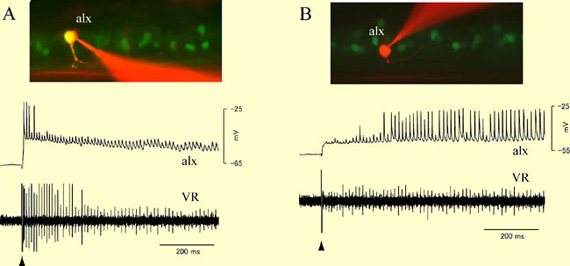Recent molecular genetic studies suggest that the expression of transcription factors in the developing spinal cord helps determine the morphological and physiological properties of neurons. Using the zebrafish preparation, we have examined the properties of neurons marked by alx, a zebrafish homolog of mammalian Chx10. We performed morphological and physiological studies using transgenic zebrafish expressing fluorescent reporter constructs in cells that had at any time point expressed alx (alx neurons). Our data reveal that zebrafish alx neurons are all ipsilateral descending neurons that are positive for vesicular glutamate transporter 2, suggesting that they are glutamatergic excitatory interneurons. Patch recordings show that earlier-born neurons are active during stronger movements such as escapes and fast swimming (strong movement class), whereas later-born ones are involved in sustained weak swimming (weak movement class). Paired recordings between alx neurons and motoneurons show that neurons of the strong movement class make frequent monosynaptic excitatory connections onto motoneurons. Thus, neurons of this class are likely premotor interneurons that regulate motoneuron activity during escapes and fast swimming. We also show the existence of a monosynaptic connection between an alx neuron of the weak movement class and a motoneuron. Collectively, our data demonstrate that alx marks ipsilateral descending neurons that are involved in the regulation of motoneuron activity during forms of locomotion, such as escape and swimming.
Kimura Y, Okamura Y & Higashijima S (2006) alx, a zebrafish homolog of Chx10, marks ipsilateral descending excitatory interneurons that participate in the regulation of spinal locomotor circuits. J Neurosci, 26:5684-97.
